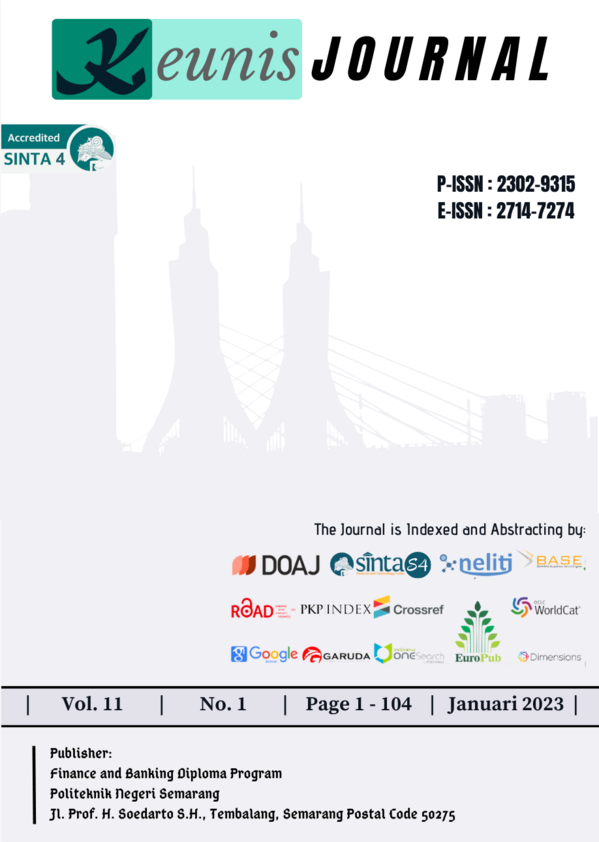THE MACRO-PRUDENTIAL POLICY AND BANK NON-PERFORMING ASSETS IN INDONESIA
DOI:
https://doi.org/10.32497/keunis.v11i1.3655Keywords:
Macro-Prudential, Bank, Non-Performing Asset, PolicyAbstract
This study examines the effect of the Macro-prudential Intermediation Ratio (MIR) as an instrument of Bank Indonesia's macro-prudential regulation on Non-Performing Assets (NPA) as one of the banking industry performance indicators in Indonesia. In addition, this study also examines several other independent variables such as bank assets as an indicator of bank size, Bank Indonesia interest rates (BI rate), and inflation as macroeconomic indicators and their effect on NPA. The NPA, MIR, and bank asset data used in this study consist of 109 commercial banks operating in Indonesia during the period from January 2015 to December 2020. This study uses an Ordinary Least Square (OLS) analysis approach by undertaking classical assumption tests and statistical tests. The results show that (1) MIR, bank assets, BI rate, and inflation simultaneously have a significant effect on NPA (2) Partially, bank assets have a negative and significant effect on NPA while other variables including macro-prudential policy have no significant effect on NPA (3) Variable MIR, bank assets, BI rate, and inflation can explain variations of NPA variable by 34% (4) Larger bank size encourages prudent financing and reduces NPA.References
Akinci, O., & Olmstead-Rumsey, J. (2015). How Effective are Macroprudential Policies? An Empirical Investigation. SSRN Electronic Journal, 1136. https://doi.org/10.2139/ssrn.2671044
Anastasiou, D., Louri, H., & Tsionas, M. (2019). Nonperforming loans in the euro area: Are core”“periphery banking markets fragmented? International Journal of Finance and Economics, 24(1), 97”“112. https://doi.org/10.1002/ijfe.1651
Avdjiev, S., Koch, C., McGuire, P., & von Peter, G. (2017). International prudential policy spillovers: A global perspective. International Journal of Central Banking, 13, 5”“33.
Bank Indonesia. (2020). Instrumen Kebijakan Makroprudensial. www.bi.go.id
Beridze, E. (2020). Macro-Prudential Policy : Essence and Meaning. Journal of Research and Innovation for Sustainable Society, 2(1), 61”“65. https://doi.org/10.33727/JRISS.2020.1.9
Bolarinwa, S. T., Akinyele, O., & Vo, X. V. (2021). Determinants of nonperforming loans after recapitalization in the Nigerian banking industry: Does efficiency matter? Managerial and Decision Economics, March, 0”“16. https://doi.org/10.1002/mde.3323
Cerutti, E., Claessens, S., & Laeven, L. (2015). The Use and Effectiveness of Macroprudential Policies: New Evidence. International Monetary Foundation.
Cerutti, E., Correa, R., Fiorentino, E., & Segalla, E. (2016). Changes in Prudential Policy Instruments. International Journal of Central Banking, 13(16/110), 477”“503.
Claessens, S., Ghosh, S. R., & Mihet, R. (2013). Macro-prudential policies to mitigate financial system vulnerabilities. Journal of International Money and Finance, 39, 153”“185. https://doi.org/10.1016/j.jimonfin.2013.06.023
Corrado, L., & Schuler, T. (2017). Interbank market failure and macro-prudential policies. Journal of Financial Stability, 33, 133”“149. https://doi.org/10.1016/j.jfs.2016.10.007
Cosmin, C. M. (2018). Considerations Regarding The Financial Stability And The Macro Prudential Policy. Annals of the ”žConstantin BrâncuÅŸi” University of Târgu Jiu, 1, 130”“138.
Dimitrios, A., Helen, L., & Mike, T. (2016). Determinants of non-performing loans: Evidence from Euro-area countries. Finance Research Letters, 18(August), 116”“119. https://doi.org/10.1016/j.frl.2016.04.008
Freixas, X., Laeven, L., & Peydró, J.-L. (2015). Systemic Risk, Crises, and Macroprudential Regulation. The MIT Press.
Gauthier, C., Lehar, A., & Souissi, M. (2012). Macroprudential capital requirements and systemic risk. Journal of Financial Intermediation, 21(4), 594”“618. https://doi.org/10.1016/j.jfi.2012.01.005
Ghosh, A. (2015). Banking-industry specific and regional economic determinants of non-performing loans: Evidence from US states. Journal of Financial Stability, 20, 93”“104. https://doi.org/10.1016/j.jfs.2015.08.004
Ghozali, I. (2018). Aplikasi Analisis Multivariat dengan Program IBM SPSS 21 (Edisi 7). Unversitas Diponogoro.
Johan, S. (2021). Determinants of Banking Industry Profitability: an Empirical Research of Indonesia Financial Institutions. EKUITAS (Jurnal Ekonomi Dan Keuangan), 5(2), 244”“262. https://doi.org/10.24034/j25485024.y2021.v5.i2.4666
Kadioglu, E., Telceken, N., & Ocal, N. (2017). Effect of the Asset Quality on the Bank Profitability. International Journal of Economics and Finance, 9(7), 60. https://doi.org/10.5539/ijef.v9n7p60
Karadima, M., & Louri, H. (2021). Economic policy uncertainty and non-performing loans: The moderating role of bank concentration. Finance Research Letters, 38(November 2019), 101458. https://doi.org/10.1016/j.frl.2020.101458
Kasmir. (2014). Bank dan Lembaga Keuangan Lainnya. Rajawali Pers.
Lestari, W. D., & Setianegara, R. G. (2020). Analisis Pengaruh NIM, BOPO, LDR, dan NPL Terhadap Profitabilitas (Studi Kasus Pada Bank Umum Yang Listed di Bursa Efek Indonesia Periode 2014-2018). Keunis Journal Finance and Business, 8(2302), 82”“92. https://doi.org/http://dx.doi.org/10.32497/keunis.v8i1
Makri, V., Tsagkanos, A., & Bellas, A. (2014). Determinants of non-performing loans: The case of Eurozone. Panoeconomicus, 61(2), 193”“206. https://doi.org/10.2298/PAN1402193M
Mankiw, N. G. (2016). Macroeconomics. Worth Publishers.
Monnin, P., & Jokipii, T. (2016). The Impact of Banking Sector Stability on the Real Economy Swiss National Bank Working Papers. Empirica, 44(2017), 295”“337. https://www.snb.ch/n/mmr/reference/working_paper_2010_05/source/working_paper_2010_05.en.pdf
NaruÅ¡eviÄius, L. (2018). Bank profitability and macroeconomy: Evidence from Lithuania. Technological and Economic Development of Economy, 24(2), 383”“405. https://doi.org/10.3846/20294913.2016.1213192
Nurdin, Y., Shahib, H. M., & Gafur, M. (2018). Pengaruh Pelanggaran Peraturan Perbankan Terhadap Kinerja Keuangan Bank Di Indonesia. EKUITAS (Jurnal Ekonomi Dan Keuangan), 2(1), 83”“105. https://doi.org/10.24034/j25485024.y2018.v2.i1.3439
Nurhasanah, D., & Maryono. (2021). Analisa Pengaruh Rasio Keuangan Terhadap Profitabilitas Pada Perusahaan Perbankan Periode 2016 ”“ 2018. Keunis Journal Finance and Business, 9(1), 85”“95. https://doi.org/DOI: http://dx.doi.org/10.32497/keunis.v9i1
Otoritas Jasa Keuangan. (2021). Statistik Perbankan Syariah. www.ojk.go.id
Perić, B. Å ., & KonjuÅ¡ak, N. (2017). How Did Rapid Credit Growth Cause Non-Performing Loans In The Cee Countries? South East European Journal of Economics and Business, 12 (2), 84”“95. https://doi.org/10.1515/jeb-2017-0019
Peydró, J. L. (2016). Macroprudential Policy and Credit Supply. Swiss Journal of Economics and Statistics, 152(4), 305”“318. https://doi.org/10.1007/BF03399430
Riani, D., & Maulani, D. (2021). Determinants of banking efficiency for commercial banks in Indonesia. Integrated Journal of Business and Economics, 5(3). https://doi.org/10.5709/ce.1897-9254.308
Wahyudi, R., Husnayeni, F., Mutmainah, L., Adha, M. A., & Rifan, A. A. (2021). Determinants of Profitability in Indonesian Islamic Banking: Case Study in the COVID-19 Period. Integrated Journal of Business and Economics, 5(1), 37”“46.
Zhang, L., & Zoli, E. (2016). Leaning against the wind: Macroprudential policy in Asia. Journal of Asian Economics, 42, 33”“52. https://doi.org/10.1016/j.asieco.2015.11.001
Downloads
Published
Issue
Section
License
KEUNIS is licensed under a Creative Commons Attribution-ShareAlike 4.0 International License.
Authors who publish with this journal agree to the following terms:
- Authors retain copyright and grant the journal right of first publication with the work simultaneously licensed under a Creative Commons Attribution-ShareAlike 4.0 International License that allows others to share the work with an acknowledgement of the work's authorship and initial publication in this journal.
- Authors are able to enter into separate, additional contractual arrangements for the non-exclusive distribution of the journal's published version of the work (e.g., post it to an institutional repository or publish it in a book), with an acknowledgement of its initial publication in this journal.
- Authors are permitted and encouraged to post their work online (e.g., in institutional repositories or on their website) prior to and during the submission process, as it can lead to productive exchanges, as well as earlier and greater citation of published work (See The Effect of Open Access).






